Australian Pulse Bulletin
Faba bean fungicide guide: 2018 season
Foliar fungicide applications will help in the management of faba bean diseases. There are four main fungal diseases of faba and broad bean that require monitoring, chocolate spot (Botrytis fabae and B. cinerea), ascochyta blight (Ascochyta fabae), Cercospora leaf spot (Cercospora zonata) and rust (Uromyces vicia-fabae).
Pulse Australia have a number of Minor Use Permits from APVMA in 2018 to help growers manage disease in faba bean crops, and these are shown in the table below along with all the currently registered products.
Decisions need to be made such as when to start the spray program and how often to spray, depending on the varietal resistance, the prevailing weather conditions and the potential yield of the crop.
Fungal disease control is based on protection of plants rather than curing infections. The first fungicide application must be applied as early as necessary to minimise the establishment of the disease. Additional applications are required if the weather conditions favour disease development and spread.
Disease monitoring should be started after crop emergence as cercospora and ascochyta blight can infect crops in the early stages. If the disease takes hold it can be very difficult to recover crops, as the fungicides have no curative action. Protective sprays may be needed in longer growing seasons until the end of podding. Fungicides remain effective for approximately 10-14 days. Keep in mind that all new growth after fungicide application is unprotected.
Timing of fungicide application is critical. These diseases can spread rapidly, so DO NOT DELAY spraying. A spray in advance of a rain front period is desirable. Delaying application until after a rain front will have much reduced efficacy.
The need for repeated fungicide applications depends on the growth stage of the crop, the time since the last fungicide application and the likelihood of further conditions favouring disease development. Unprotected crops can lose over 50% in yield. The numbers of sprays per crop is limited for some products to minimise the development of fungicide resistance. Check the labels for maximum number of sprays permitted. In high disease risk seasons, where multiple fungicide sprays are required, alternate products with different active ingredients.
Seasonal Conditions in 2018
Seasonal conditions have varied widely across Australian cropping areas. After a very hot and dry summer in many regions and variable autumn break for sowing crops, conditions in many regions have become cold and dry, with frosty mornings. In Qld and Northern NSW drought conditions have prevailed with record low rainfall and virtually no winter crops sown. South Eastern NSW has had some reasonable rainfall, but below average, and crops are progressing slowly. In South West NSW though many crops are suffering moisture stress and are well below average. Victoria and South Australia also have had below average conditions but at least have had enough rainfall to get crops established reasonably well. Further rain will be needed in spring to finish these crops. In Western Australia the southern and eastern grain belts have had good conditions. These conditions have meant that diseases have not been favoured even though many need only limited moisture to infect crops (heavy dew may provide enough moisture). Monitoring needs to be continued through the different growth stages of the crop. With good access for ground sprayers this year, allowing for high water rates and canopy penetration, timely fungicide application will give the crop the best chance of a high yield.
For more detailed information on disease management:
- Faba bean: Integrated disease management
- CropPro faba bean disease manual
- Fungicide resistance in grain crops (including pulses)
-
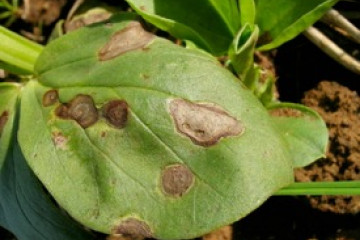
Cercospora (SARDI)
-
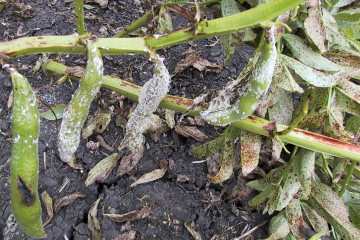
Mouldy pods caused by chocolate spot
-
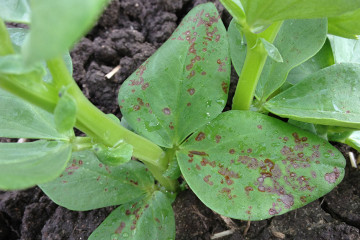
Early indications of chocolate spot
-
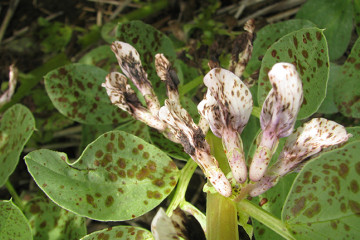
Chocolate spot on faba bean leaves and flowers (J Davidson).
-
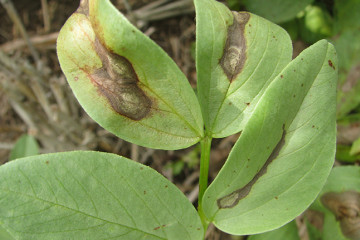
Ascochyta blight on faba bean leaves (J Davidson).
Fungicide Minor Use Permits for faba bean 2018
- PER13752 Tebuconazole / Faba Beans & Broad Beans / Cercospora leaf spot & Rust / Current to 30-Jun-2019
Fungicides registered for use for faba bean
| Faba Bean Foliar Fungicide
|
Trade Name example
|
Chocolate Spot
|
Rust
|
Ascochyta
|
Cercospora
|
WHP Harvest
|
|---|---|---|---|---|---|---|
| Chlorothalonil 720
|
CC Barrack 720
|
1.4-2.3 L/ha
|
1.4-2.3 L/ha
|
NR
|
NR
|
7 days
|
| Mancozeb 750
|
Dithane SC
|
NR | 1.7–2.2 L/ha
|
1.7–2.2 L/ha
|
1.7–2.2 L/ha
|
7 days
|
| Carbendazim
|
Spin Flo
|
500 mL/ha
|
NR
|
NR
|
NR
|
28 days
|
| Procymidone 500
|
Sumislex 500
|
500 mL/ha
|
NR
|
NR
|
NR
|
9 days
|
| Copper
|
Champ 500DF
|
1.2 kg/ha
|
1.2 kg/ha
|
NR
|
NR
|
1 day
|
| Metiram
|
Polyram DF
|
1.0–2.2 kg/ha
|
1.0–2.2 kg/ha
|
1.0–2.2 kg/ha
|
1.0–2.2 kg/ha
|
42 days
|
| Tebuconazole
|
Folicur SC
|
NR
|
Permit 145 mL/ha
|
NR
|
Permit 145 mL/ha
|
21 days
|
| Prothioconazole + Tebuconazole
|
Prosaro 420 SC
|
NR
|
NR
|
Permit 600–750 ml/ha
|
NR
|
21 days
|
| Azoxystrobolin + Tebuconazole
|
Veritas
|
Permit 1.0 L/ha
|
NR
|
Permit 1.0 L/ha
|
NR
|
28 days
|
| Cyprodinal
|
Solaris 300EC
|
NR
|
NR
|
Permit 500 mL/ha
|
NR
|
14 days
|
Many Minor Use Permits have short term expiry dates (e.g. 30/11/2017)
NR = Not Registered
Read the LabelAs with any chemical application, care should be taken to observe all the label conditions for each product. Some label advice is different for each state or region, so for best results, it is important that this is followed. Many of our pulse crops are exported for human consumption, so market access is dependent on having the product free of chemical residues. Australian has a reputation for providing clean and safe produce so it is vital that this is maintained by using chemicals according to regulations. All permits have label recommendations for use rate and withholding periods (WHP) that must be observed so grain will comply with Maximum Residue Limits (MRL) allowable for market access. |
Key contacts
Pulse Australia Industry Development Managers
- Paul McIntosh
Phone: 0429 566 198 - Phil Bowden
Phone: 0427 201 946
Support and funding acknowledgement
Disclaimer
Information provided in this guide was correct at the time of the date shown below. No responsibility is accepted by Pulse Australia for any commercial outcomes from the use of information contained in this guide.
The information herein has been obtained from sources considered reliable but its accuracy and completeness cannot be guaranteed. No liability or responsibility is accepted for any errors or for any negligence, omissions in the contents, default or lack of care for any loss or damage whatsoever that may arise from actions based on any material contained in this publication.
Readers who act on this information do so at their own risk.
Copyright © 2015 Pulse Australia
All rights reserved. The information provided in the publication may not be reproduced in part or in full, in any form whatsoever, without the prior written consent of Pulse Australia. www.pulseaus.com.au
Last updated: 24 August 2018

